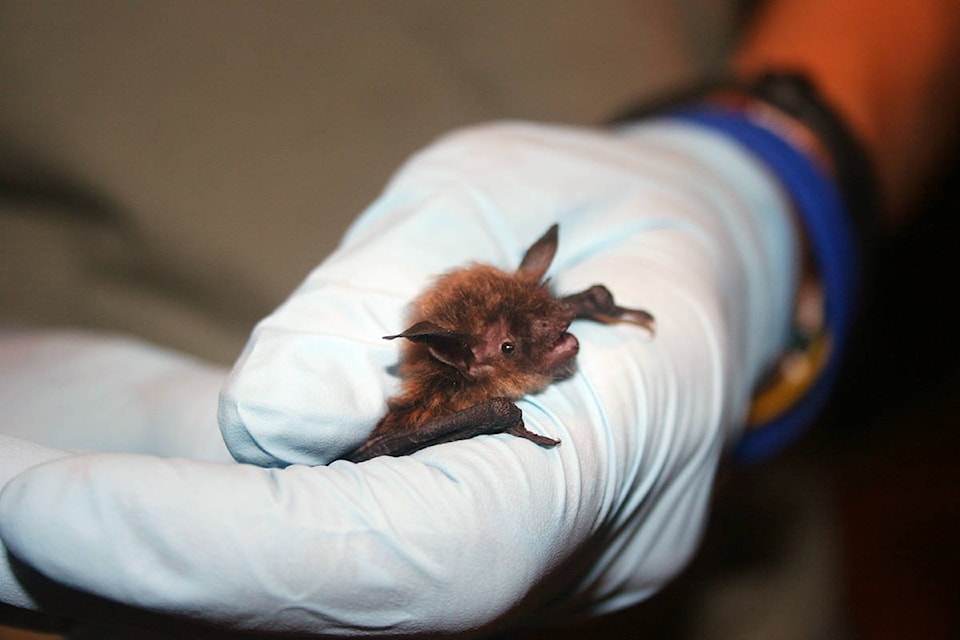While people in B.C. continue to practice physical distancing, bats are closer to humans now more than any other time of the year.
Late summer is when people typically notice an increase in bat activity. That can include bats flying into homes or roosting in unusual locations.
Ashleigh Ballevona, regional coordinator with the Skeena Community Bat Program, said that bats are physically closer to people, and are more likely to be spotted on the ground, during this time of year.
“This is typically when we get the most calls about a bat in a weird spot or a bat that has maybe come into a house,” she said.
Female bats congregate in maternal colonies early in the summer. They stay there until their pups are ready to fly. When pups are spreading their wings, they can end up in odd places.
According to the BC Community Bat Program, it is important not to touch live or dead bats with bare hands, even though rabies infection in B.C. bats is uncommon. When normal bat populations are randomly sampled, less than 0.5 per cent test positive for rabies.
Still, rabies can be fatal in humans, so it is important to to take precautions. Call Health Link 811, a doctor or veterinarian if a person or pet may have been bitten or scratched by a bat.
READ MORE: B.C. man dies from rabies after contact with Vancouver Island bat
Should someone need to remove a single bat from a room, Ballevona said they can close the door and open a window and the bat will usually fly out. If the bat needs to be handled, people should wear leather gloves and long sleeves. Trap the bat with a cardboard box or similar container.
Bats are vulnerable during the day, so they should only be released at night. If the bat must be in the box for several hours before it is released, Bat Conservation International recommends taping a soft t-shirt on the inside of the box before capturing the bat so it has something to hang from. Do not use a towel – the bat’s claws could become entangled.
When it is dark, release the bat from an elevated location like a tree branch or ladder so that the bat is safe from cats and other predators.
“The other thing you can do, and I’ve also done this, is to place the bat inside a pillow case and then with the open end up, tacking that pillow case somewhere on the side of a house or a building high enough,” said Ballevona.
“The bat can actually crawl out of the pillowcase when it’s ready, so kinda all about giving it its opportunity to fly away.”
Some B.C. bats have adapted to living in human structures like barns, attics or under siding and roofs. Ballevona said that most of the time those roosts are known to the property owner.
Bats are pollinators and seed distributors, they are also effective at controlling insects. Some home and landowners welcome bats for those reasons, but others may choose to exclude bats. Harming or killing bats is illegal under the BC Wildlife Act.
According to Ballevona, nine of B.C.’s 15 bat species live in the Skeena region, and nearly half of the province’s bat species are classified as at risk. The little brown myotis, better known as the little brown bat is one of the more common species in B.C., but it is endangered Canada-wide.
“One thing we like to make sure people know about is if they are doing any renovations on their house, particularly any roof work, to wait if they know they have bats,” said Ballevona,
“If they start to do work, say they have a roofer come and they start to take off the roof and they notice that there is a colony of bats there, to hold off and wait until the fall because the bats will leave.”
In the fall, bats move on to places with stable temperatures and humidity like caves or mines to hibernate for the winter.
For more information about bats and bat-friendly renovations, contact Skeena Bats at skeena@bcbats.ca or call 1-855-9BC-BATS ext. 19.
READ MORE: The BC Community Bat Program’s annual bat count set to kick off in June
@BenBogstie
ben.bogstie@terracestandard.com
Like us on Facebook and follow us on Twitter.
